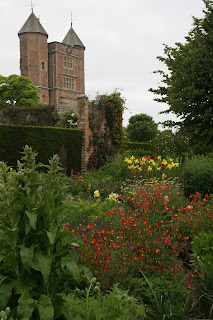 It's all about timing. My trip to the Chelsea Flower Show
and gardens in the UK this year occurred after that country experienced the
coldest spring in fifty years, and yet rhododendrons and azaleas were in full,
glorious bloom coinciding with my visit.
It's all about timing. My trip to the Chelsea Flower Show
and gardens in the UK this year occurred after that country experienced the
coldest spring in fifty years, and yet rhododendrons and azaleas were in full,
glorious bloom coinciding with my visit.
The effect of this exceptionally late spring wasn't apparent
at the Chelsea Flower Show where, on the one hundredth anniversary of the
event, the show gardens were as jaw dropping as ever. Organisers and
participants have long ago mastered the challenges of ensuring plants and
flowers are at their immaculate best for the five days of the show. It’s not
unknown to use a hair dryer to encourage a tardy poppy to bloom. No doubt
plants would be broiled or braised if necessary to achieve horticultural perfection.
Much was made in the media this year about the decision to
allow garden gnomes a presence, having been previously banned. I expected to
see hordes of the little fellas, but no, I only spotted two, and these were in
the garden designed by Prince Harry and prominent landscape architect Jenny
Bloom. The garden, a representation of a Lesotho village, was created to
promote Prince Harry’s African Aids Orphans charity and in memory of his mother
Princess Diana.
Of course, with the range of eccentric characters one sees
at the show, first event of the social season in Britain, gnomes could easily
have blended in with the crowds, and there were crowds. The five day show was
sold out as usual with tickets online going for hundreds of dollars. Despite
the number of visitors, it does not detract from the experience as this is not
a rock concert crowd but a gathering of enthusiastic plant and garden lovers
from around the world, full of enthusiasm and good will. No pushing or shoving,
even politer than Canadians are reputed to be.
Another highlight was my first visit to Great Dixter, home
and garden of the late Christopher Lloyd. Lloyd, revered by gardeners worldwide
was a preeminent plantsman, garden writer, and television personality.
Now operated as a private trust with an educational mandate,
this rambling yet cleverly structured garden was originally designed by
renowned architect Sir Edwin Lutyens for Lloyd’s parents, Nathaniel and Daisy,
after they acquired the fifteenth century house in 1909. It is as glorious as
ever, though it has never remained static. Lloyd learned gardening skills from
his mother, then boldly modified and enhanced many aspects of the garden in the
thirty years following Daisy’s death in 1972. After Lloyd’s death in 2006, head
gardener, Fergus Garret, has continued to care for the garden.
 He experimented boldly, creating unique combinations of
colour and form. I saw bright crimson tulips soar through swaths of blue forget-me-knots,
masses of cow parsley (yes that weed) tempering the kaleidoscopic springtime blaze
of poppies, euphorbia, wallflowers, and bluebells. Soft and low boxwood hedges
combine with huge ones of yew to form an erratic maze of delights connecting
the many sections, or garden rooms, while giant topiary mounds topped by
figures of birds, stand like sentinels. Known for his succession planting
schemes that ensured colour throughout all seasons, the shrubs, climbers,
perennials, annuals, and biennials in beds and mixed borders ensure something
is always exploding into bloom.
He experimented boldly, creating unique combinations of
colour and form. I saw bright crimson tulips soar through swaths of blue forget-me-knots,
masses of cow parsley (yes that weed) tempering the kaleidoscopic springtime blaze
of poppies, euphorbia, wallflowers, and bluebells. Soft and low boxwood hedges
combine with huge ones of yew to form an erratic maze of delights connecting
the many sections, or garden rooms, while giant topiary mounds topped by
figures of birds, stand like sentinels. Known for his succession planting
schemes that ensured colour throughout all seasons, the shrubs, climbers,
perennials, annuals, and biennials in beds and mixed borders ensure something
is always exploding into bloom.
Lloyd certainly had the eye of an artist, or it could be
easy to believe he simply wandered about wearing an old jacket, countless seeds
carelessly spilling from the holes in his pockets, accidentally creating
heavenly vistas.
No matter the timing, there are always so many amazing plants
to see in Britain. Meanwhile,
I’m back in my own garden, trying to sort the plants from
the weeds that took advantage of my absence — bad timing!
















